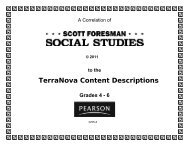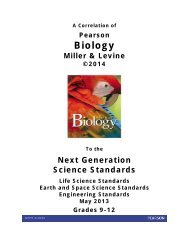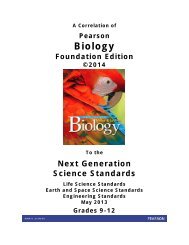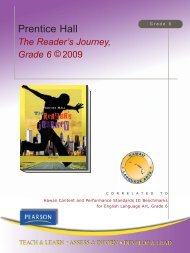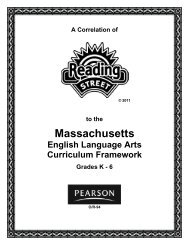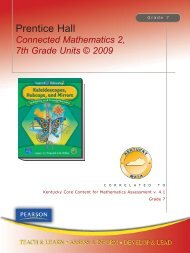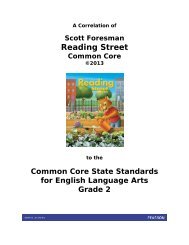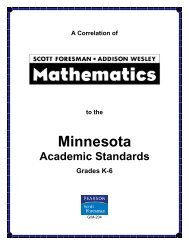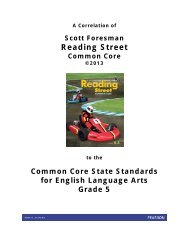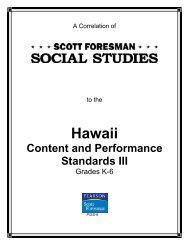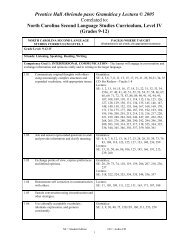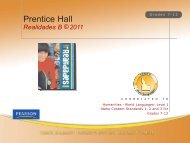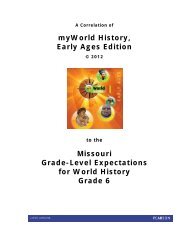Prentice Hall Mathematics, Algebra 2 Foundations ©2011
Prentice Hall Mathematics, Algebra 2 Foundations ©2011
Prentice Hall Mathematics, Algebra 2 Foundations ©2011
You also want an ePaper? Increase the reach of your titles
YUMPU automatically turns print PDFs into web optimized ePapers that Google loves.
<strong>Prentice</strong> <strong>Hall</strong><strong>Mathematics</strong>, <strong>Algebra</strong> 2 <strong>Foundations</strong> © 2011<strong>Algebra</strong> IIC O R R E L A T E D T OWest Virginia 21st Century <strong>Mathematics</strong>Content Standards and Objectives for <strong>Algebra</strong> II
PUBLISHER:Pearson Education, Inc., publishing as <strong>Prentice</strong> <strong>Hall</strong>SUBJECT:<strong>Mathematics</strong>SPECIFIC GRADE: 10-12COURSE:<strong>Algebra</strong> IITITLE:<strong>Prentice</strong> <strong>Hall</strong> <strong>Mathematics</strong>, <strong>Algebra</strong> 2, The <strong>Foundations</strong> SeriesCOPYRIGHT DATE: 2011SE ISBN: 0133696588TE ISBN: 0785469249GENERIC EVALUATION CRITERIA2010-2015<strong>Mathematics</strong><strong>Algebra</strong> IIR-E-S-P-O-N-S-EYes No N/A CRITERIA NOTESxI. INTER-ETHNICThe instructional material meets therequirements of inter-ethnic: concepts, contentand illustrations, as set by West Virginia Board ofEducation Policy (Adopted December 1970).xII. EQUAL OPPORTUNITYThe instructional material meets therequirements of equal opportunity: concept,content, illustration, heritage, roles contributions,experiences and achievements of males andfemales in American and other cultures, as setby West Virginia Board of Education Policy(Adopted May 1975).1
INSTRUCTIONAL MATERIALS ADOPTION: 21 st CENTURY LEARNING EVALUATION CRITERIAGENERAL EVALUATION CRITERIA2010-2015<strong>Mathematics</strong><strong>Algebra</strong> II(Vendor/Publisher)SPECIFIC LOCATION OFCONTENT WITHIN PRODUCT(IMR Committee) ResponsesI=In-depth A=Adequate M=Minimal N=NonexistentI A M NIn addition to alignment of Content Standards and Objectives (CSOs), materials must also clearly connect toLearning for the 21 st Century which includes opportunities for students to developA. Learning SkillsAddressed throughoutthe text. Samplecitations follow:SE/TE: 4-6, 53, 64-67,110, 135, 184-188,192, 269, 281, 361-364, 368, 451, 462-466, 508, 565-568,572, 622, 641-646,674, 686-692, 698,725, 760, 809, 858-860• Thinking and Problem-Solving Skills/ Rigor and Depth of ContentContent is presented in a way that deepens student understandingthrough engagement in meaningful, challenging mathematics thatbuilds on prior knowledge and promotes connections amongmathematical concepts.• Thinking and Problem-Solving Skills /Development of ConceptualUnderstandingLearning opportunities require students to develop their own viablemathematical understandings and help them build connectionsbetween mathematical ideas.• Information and Communication Skills/Mathematical LanguageAppropriately introduce and reinforce in multiple ways all necessaryterms and symbols.• Personal and Work Place Productivity Skills2
B. 21 st Century ToolsSeePower<strong>Algebra</strong>.com,the digital environmentfor <strong>Prentice</strong> <strong>Hall</strong> HighSchool <strong>Mathematics</strong>,for videos, audios,dynamic activities andmath tools, thePearson VideoChallenge, and more.Also cited throughoutthe text; see especiallyMy Math Video,Dynamic Activities,and Concept Bytes.Sample citationsfollow:SE/TE: 3, 63-64, 121,145, 162, 164, 175,203, 212, 231, 255,291, 379, 443, 461,488-489, 499, 507,519, 583, 633, 685,771, 780, 848Also seewww.pearsonsuccessnet.com.• Problem-solving tools (such as spreadsheets, decision support, designtools)• Communication, information processing and research tools (such as wordprocessing, e-mail, groupware, presentation, Web development, Internetsearch tools)• Personal development and productivity tools (such as e-learning, timemanagement/calendar, collaboration tools)3
INSTRUCTIONAL MATERIALS ADOPTION: 21 st Century Learning EVALUATION CRITERIAThe general evaluation criteria apply to each grade level and are to be evaluated for each grade level unless otherwise specified. These criteria consist ofinformation critical to the development of all grade levels. In reading the general evaluation criteria and subsequent specific grade level criteria, e.g. means“examples of” and i.e. means that “each of” those items must be addressed. Eighty percent of the combined general and specific criteria must be met with I(In-depth) or A (Adequate) in order to be recommended.2010-2015<strong>Mathematics</strong><strong>Algebra</strong> II(Vendor/Publisher)SPECIFIC LOCATION OFCONTENT WITHIN PRODUCT(IMR Committee) ResponsesI=In-depth A=Adequate M=Minimal N=NonexistentI A M NFor student mastery of content standards and objectives, the instructional materials will provide students with the opportunity to4. MultimediaSee Power<strong>Algebra</strong>.com, thedigital environment for <strong>Prentice</strong><strong>Hall</strong> High School <strong>Mathematics</strong>, forvideos, audios, dynamic activitiesand math tools, the PearsonVideo Challenge, and more.Dynamic Activities are cited atpoint of use throughout the text.Sample citations:SE/TE: 39, 121, 227, 243, 255,260, 444, 463, 470, 521, 592, 649,723, 745, 848, 666, 6951. offer appropriate multimedia (e.g., software, audio, visual, internetaccess) materials.4
See Power<strong>Algebra</strong>.com, a digitalenvironment with videos, audios,dynamic activities and math tools,the Pearson Video Challenge, andmore.2. provide a website which provides links to relevant sites as well aslesson plans, student activities and parent resources.5
Technology is integratedthroughout the text; see especiallyConcept Bytes, DynamicActivities, and graphing calculatorProblems. Sample citations:SE/TE: 64, 121, 162, 164, 175,212, 231, 255, 291, 294, 305-306,342, 353-356, 404, 443, 488-489,499, 507, 640, 650, 780, 848Addressed throughout the text;see especially Solve Its and Pull ItAll Together. Sample citations:SE/TE: 11, 53, 88, 154, 176, 192,227, 347, 368, 417, 451, 508, 555,572, 607, 622, 674, 760, 772, 809See Pull It All Together Samplecitations:SE/TE: 53, 135, 192, 281, 368,451, 508, 572, 622, 674, 760, 809Addressed throughout the text;see especially Writing exercisesand Solve Its. Sample citations:SE/TE: 7, 25, 38, 79, 107, 149,152, 156, 205, 207, 210, 313, 343,373, 441, 486, 558, 571, 605, 641,648, 652, 657-658, 666, 689, 698,702, 725, 758, 778, 825, 836, 846,861Addressed throughout the text;see especially Reasoningexercises and Got Its, andKnow/Need/Plan and Think/WriteProblems. Sample citations:SE/TE: 4, 6, 20, 66, 115, 158,170, 217, 232, 302, 384, 418, 434,499-500, 524, 557, 594, 602, 616,635, 643, 712, 726, 783, 804, 8383. Integrate technology seamlessly when appropriate to modelmathematical situations, analyze data, calculate results, and solveproblems.B. Scientifically-Based Research Strategies1. Consistently require students to link prior knowledge to newinformation to construct their own viable understandings ofmathematical ideas.2. Consistently provide opportunities for students to solve complexproblems that have multiple entry points and the possibility of multiplesolution processes.3. Consistently provide opportunities for students to communicate theirmathematical thinking processes to others orally, in writing, orpictorially.4. Routinely require students to develop and defend mathematicalconjectures, arguments, reasoning and proof.6
See Concept Bytes and Solve Its.Sample citations:SE/TE: 11, 26, 121, 162, 176,251, 252, 318, 332, 346, 387, 426,491, 508, 584, 607, 711Addressed throughout the text.Sample citations:SE/TE: 4-6, 64-67, 146-147, 244,261, 363, 407, 428, 476, 688Addressed throughout theTeacher Edition. See LessonResource on Teacher Editionpages A and B after every lesson.5. Provide opportunities for the students to be involved in investigationsthat enable them to make connections among mathematical ideas.6. Expect students to develop multiple representations of themathematics in order to depict reasoning used to explain real worldphenomena or solutions to relevant problems and move fluentlybetween those representations.7. Present varied teaching models with emphasis on differentiatedinstruction in content, process, and product.7
C. Critical ThinkingAddressed throughout the text;see especially Reasoningexercises and Got Its. Samplecitations:SE/TE: 6, 39-40, 66, 109, 126,158, 165, 170, 217, 229, 232, 267,302, 344, 384, 424, 434, 499, 506,524, 577, 594, 597, 602, 627, 635,640, 712, 741, 783, 807, 838-839Addressed throughout the text;see especially Solve Its and ErrorAnalysis exercises. Samplecitations:SE/TE: 11, 32, 79, 121, 152, 162,214, 220, 316, 332, 424, 426, 491,496, 520, 562, 584, 597, 607, 662,711, 738, 861Addressed throughout the text.Sample citations:SE/TE: 28, 65, 147, 208, 217,355, 396, 419, 438, 466, 567, 595,644, 652, 661, 700, 794, 8251. emphasize questioning models to promote higher order thinking skillsbased on depth of knowledge.2. Consistently require students to discuss mathematics with eachother and with the teacher, make arguments, conjecture andreason, and justify/clarify their ideas in writing and orally inprecise mathematical symbols and language.3. Present real world application that is current, engaging, integratedthroughout the instruction, and promotes and develops criticalthinking.D. Life SkillsAddressed throughout the text;see especially Solve Its and thePearson Video Challenge atPower<strong>Algebra</strong>.com. Samplecitations:SE/TE: 3, 19, 57, 63, 128, 154,182, 291, 379, 426, 431, 453, 477,609, 685, 781, 7991. address life skills (e.g., reading road maps, using reference tools,researching, reading a newspaper, using want ads, completing anapplication, applying the interview process and goal setting).8
Addressed throughout the text;see especially Tips for Successand Think/Plan margin notes.Sample citations:SE/TE: 58, 104, 140, 198, 228,286, 374, 390, 456, 514, 523, 578,628, 642, 680, 740, 766, 8242. address habits of mind activities (e.g., literacy skills, interpersonalcommunications, problem solving and self-directional skills).E. Classroom ManagementAddressed throughout the text;see certain Solve Its and ConceptBytes. Sample citations:SE/TE: 18, 33, 128, 162, 175-176,251-252, 279-280, 318, 332, 346,387, 426, 443, 584, 592, 711, 744Addressed throughout the text;see My Math Video, and certainSolve Its and Concept Bytes.Sample citations:SE/TE: 3, 18, 63, 128, 175-176,203, 291, 379, 395, 443, 461, 519,583, 633, 685, 771-772Addressed throughout the text;see Lesson Resource pages atthe end of each lesson in the TE.Sample citations:TE: 24A, 120A, 191A, 225A,317A, 401A, 479A, 546A, 598A,648A, 710A, 798A1. include opportunities for large group, small group, and independentlearning.2. Consistently require students to explore mathematical ideas,individually and collaboratively, while integrating the processstandards (see Section I of this rubric).3. provide suggestions for differentiated instruction (e.g., practiceactivities, learning stations, assessment, lesson plans).9
F. Instructional MaterialsAddressed throughout the text;see each lesson, the WVstandards listed at the front of thetext, and the All-In-One TeacherResource.Addressed throughout the text;see especially Open-Endedexercises and Problems that aredone using two different methods.Sample citations:SE/TE: 4-9, 24, 55, 146-147, 210,339, 363, 407, 428, 455, 476, 553,584-590, 612, 624, 688, 750, 846Addressed throughout the text;see Teacher Support in eachlesson of the TE, and the FocusQuestions found throughout theSE. Sample citations follow:SE: 14-15, 90, 159, 229, 272, 315,364, 419, 447, 544, 611, 646, 749,776, 838See All-in-One TeachingResources.Addressed throughout the text;see Lesson Resource pages atthe end of each lesson in theTeacher’s Edition. Samplecitations:TE: 24A, 120A, 191A, 225A,317A, 401A, 479A, 546A, 598A,648A, 710A, 798A1. Are organized according to WV content standards or other incrementsthat allow students to investigate and explore major mathematicalideas; provide a variety of lessons, activities, and projects from whichto choose; and emphasize connections between mathematical ideas.2. Consistently integrate tasks that engage students and invite them tospeculate and hypothesize, are open-ended, and require them todetermine appropriate strategies.3. Provide teachers with guiding questions to aid students’ developmentof mathematical discourse to further mathematical understanding.4. Provide additional resources that are organized in a way that is easyto access and use.5. Include various instructional models to address varied learning stylesof students.10
Addressed throughout the text;see Lesson Resource pages atthe end of each lesson in theTeacher’s Edition. Samplecitations:TE: 24A, 120A, 191A, 225A,317A, 401A, 479A, 546A, 598A,648A, 710A, 798ASee All-in-One TeachingResources.The Process Standards areintegrated throughout the text withappropriate teacher support. SeeSection H of this document.Addressed throughout the TE; seeespecially the Math Background atthe start of each chapter and theLesson Opener at the start ofeach lesson. Sample citations:TE: 3A-B, 4, 63A-B, 64, 145A-B,146, 203A-B, 204, 291A-B, 292,379A-B, 380, 461A-B, 462, 519A-B, 520, 583A-B, 584, 633A-B,634, 685A-B, 686, 771A-B, 772,823Addressed throughout the text;see especially Solve Its, GetReady, Mixed Reviews, andCumulative Test Prep. Samplecitations:SE/TE: 1, 11, 32, 53, 58-61, 88,109, 140-143, 153-154, 176, 192,198-201, 225, 227, 286-289, 326,347, 368, 374-377, 417, 442, 451,456-459, 487, 508, 514-517, 555,564, 572, 578-581, 598, 607, 622,628-631, 665, 674, 680-683, 751,760, 766-769, 772, 779, 809, 8476. Provide extensive and varied opportunities to differentiate individualneeds for skill-building.7. Provide supplemental materials for intervention and enrichment.8. Provide teachers with support to properly integrate the processstandards using the available resources.9. Include a teacher resource that builds content knowledge for theteacher.10. Spiral previously taught skills and strategies with new content.11
See the Cumulative Test Preps atthe end of each chapter and theWV Progress MonitoringAssessment resource. Samplecitations:SE/TE: 58-60, 140-142, 198-200,286-288, 374-376, 456-458, 514-516, 578-580, 628-630, 680-682,766-768, 814-821Addressed throughout the text;see especially Pull It All Together(and the rubric on page 53), SolveIts, Short and Extended Responsequestions, and the Pearson VideoChallenge at Power<strong>Algebra</strong>.com.Sample citations:SE/TE: 3, 19, 57, 60, 63, 109,128, 135, 142, 154, 182, 200, 281,288, 291, 376, 379, 426, 431, 451,453, 458, 469, 477, 516, 580, 609,622, 630, 682, 685, 760, 768, 781,799, 816, 821, 827, 857TE: 53See West Virginia ProgressMonitoring Assessments.Addressed throughout the text;see especially Pull It All Together,Solve Its, Short and ExtendedResponse questions, and thePearson Video Challenge atPower<strong>Algebra</strong>.com. Samplecitations:SE/TE: 3, 19, 57, 60, 63, 109,128, 135, 142, 154, 182, 200, 281,288, 291, 376, 379, 426, 431, 451,453, 458, 469, 477, 516, 580, 609,G. Assessment1. provide assessment formats commensurate with WV assessmentprograms (e.g., WESTEST, NAEP, State Writing Assessment,informal assessments, PLAN, EXPLORE, ACT and SAT).2. provide opportunities for assessment based on performance-basedmeasures, open-ended questioning, portfolio evaluation, rubrics andmultimedia simulations.3. provide benchmark and ongoing progress monitoring.4. provide rubric-based differentiated assessment.12
622, 630, 682, 685, 760, 768, 781,799, 816, 821, 827, 857TE: 53In the digital environment atPower.<strong>Algebra</strong>.com,SuccessTracker providesteachers with the capabilities tomanage and interpret data forstudents, classes, and beyondalong with remediation options forstudents based on performance inthe various assessments offered.Addressed throughout the text;see the Chapter Reviews,especially Connecting Big Ideas.See the self-quiz for each lessonat Power<strong>Algebra</strong>.com. Samplecitations:SE/TE: 54, 136, 193, 282, 369,452, 509, 573, 623, 675, 761, 810,863Addressed throughout the text;see especially Get Ready, Got Its,Lesson Checks, and ChapterTests. Also see Performance Taskin All-In-One Teaching Resources.Sample citations:SE/TE: 1, 36-37, 57, 61, 101, 112,117, 139, 143, 158-159, 197, 201,205, 229, 240, 285, 289, 316, 320,330, 373, 377, 403-404, 415, 455,459, 492, 501, 513, 517, 535, 540,577, 581, 604, 608, 627, 631,645-646, 679, 683, 721, 733-735,765, 769, 813, 854, 860Addressed throughout the text;see especially Cumulative TestPrep, Pull It All Together, and thePerformance Task in All-In-OneTeaching Resources. Sample5. provide an electronic system for managing assessment data tofacilitate the implementation of tiered instruction6. integrate student self-assessment for and of learning by providingtools and organizers that are linked to clearly identified learning goals.7. Integrate formal and informal means of assessment in the materialsfor diagnostic, formative, and summative purposes.8. include various types of assessments: performance tasks, multiplechoice, short answer, and free response.13
citations:SE/TE: 53, 58-60, 121, 140-142,192, 198-200, 281, 286-288, 368,374-376, 451, 456-458, 508, 514-516, 572, 578-580, 622, 628-630,674, 680-682, 760, 766-768, 809,814-82114
H. Process StandardsAddressed throughout the text;see especially Challengeexercises and Pull It All Togetherfeatures. Sample citations:SE/TE: 53, 121, 192, 226, 278-281, 368, 451, 508, 572, 622, 640,674, 760, 809Addressed throughout the text;see especially Solve Its, Writingexercises, and Error Analysisexercises. Sample citations:SE/TE: 11, 22, 24, 32, 79, 107-108, 121, 152, 162, 214, 220,223-224, 316, 332, 424, 426, 474,491, 496, 502, 507, 520, 562, 584,597, 607, 638, 662, 711, 738, 787,839, 861Addressed throughout the text;see especially Solve It; LessonCheck; “Think” and “Plan” calloutsfor each example Problem.Sample citations:SE/TE: 4, 6, 20, 34, 66-67, 104-105, 115, 158, 170, 187, 213, 217,228, 232, 296, 302, 324, 384, 388,397-398, 418, 434, 493-494, 499-500, 524, 542, 550, 557, 566, 594,602, 608-609, 616, 635, 643, 712,726, 739, 783, 804, 829, 838Addressed throughout the text.Sample citations:SE/TE: 28, 49, 65, 147, 208, 217,323, 355, 396, 419, 438, 466, 524,536, 567, 595, 644, 652, 661, 700,794, 8251. Problem Solving: Provide frequent opportunities for students toformulate, grapple with, and solve complex problems that require asignificant amount of effort and have multiple viable solution paths.2. Communication: Routinely challenge students to communicate theirthinking to others orally, in writing, and/or pictorially, using precisemathematical language.3. Reasoning and Proof: Provide frequent opportunities for students tocomplete mathematical investigations with and without technology;develop conjectures, mathematical arguments and proofs to confirmthose conjectures.4. Connections with <strong>Mathematics</strong>: Consistently establish connections,and provide opportunities for students to establish connections,among mathematical concepts and their real-world applications.15
Addressed throughout the text.Sample citations:SE/TE: 5-6, 64-67, 146-147, 244,261, 279-280, 363, 407, 428, 476,566-568, 688, 842, 8545. Representations: Provide frequent opportunities for students todevelop multiple representations of the mathematics in order to depictreasoning used to explain real world phenomena or solutions torelevant problems and move fluently between those representations.16
SPECIFIC EVALUATION CRITERIA<strong>Mathematics</strong><strong>Algebra</strong> II<strong>Algebra</strong> II objectives emphasize the use of investigation to more advanced functions, using them to solve real-world problems.Focus is on multiple representations to develop conjectures, testing and justifying validity. Calculators, computers, and interactiveutilities are an integral part of instruction. The West Virginia Standards for 21st Century Learning include the following components: 21stCentury Content Standards and Objectives and 21st Century Learning Skills and Technology Tools. All West Virginia teachers areresponsible for classroom instruction that integrates learning skills, technology tools and content standards and objectives.Standard 2: <strong>Algebra</strong>Through communication, representation, reasoning and proof, problem solving, and making connections within and beyond thefield of mathematics, students will• demonstrate understanding of patterns, relations and functions,• represent and analyze mathematical situations and structures using algebraic symbols,• use mathematical models to represent and understand quantitative relationships, and• analyze change in various contexts.17
(Vendor/Publisher)SPECIFIC LOCATION OFCONTENT WITHIN PRODUCT(IMR Committee) ResponsesI=In-depth A=Adequate M=Minimal N=NonexistentI A M NFor student mastery of content standards and objectives, the instructional materials will …A. <strong>Algebra</strong>SE/TE: 81-97, 99-101SE/TE: 300-312SE/TE: 212-225, 227-236SE/TE: 268-278, 284-2851. Provide a variety of opportunities to determine equationsof lines including parallel, perpendicular, vertical andhorizontal lines, and compare and contrast the propertiesof these equations.2. Provide a variety of examples and exercises to factorhigher order polynomials by applying various methodsincluding factoring by grouping and the sum anddifference of two cubes.3. Provide a variety of opportunities to analyze and describethe relationship between the factored form and thegraphical representation.4. Provide a variety of examples and exercises to definecomplex numbers, simplify powers of ‘i’, perform basicoperations with complex numbers, and give answers ascomplex numbers in simplest form.18
SE/TE: 383-386, 402-410, 413-415, 417-424, 5. Provide a variety of examples and exercises to simplifyexpressions involving radicals and fractional exponents,convert between the two forms, and solve equationscontaining radicals and exponents.SE/TE: 243-277, 283-2856. Provide a variety of examples and exercises to solvequadratic equations over the set of complex numbers:apply the techniques of factoring, completing the square,and the quadratic formula; use the discriminate todetermine the number and nature of the roots; identify themaxima and minima.SE/TE: 268-2787. Provide a variety of opportunities to use words, graphs,tables, and equations to generate and analyze solutionsto practical problems that involve quadratic equations overthe set of complex numbers.SE/TE: 184-191, 196-197, 772-788, 804-807, 811-813 8. Consistently develop and use the appropriate fieldproperties of matrices by adding, subtracting, andmultiplying; solve a system of linear equations usingmatrices; and apply skills toward solving practicalproblems.SE/TE: 64-73, 98, 101, 426-443,453-455 9. Provide a variety of examples and exercises that define afunction and find its zeros; express the domain and rangeusing interval notation; find the inverse of a function; findthe value of a function for a given element in its domain;and perform basic operations on functions includingcomposition of functions.19
SE/TE: 81-97, 103-134, 204-210,361-367, 444-450, 462-463,470-475, 530-537SE/TE: 81-97, 103-134, 204-210,292-308, 361-367, 444-450,462-463, 470-475, 530-537SE/TE: 279-280, 814SE/TE: 162-175, 195, 197SE/TE:74-80, 99, 101, 520-528SE/TE: 634-639, 640, 641-648,649-656, 657, 658-665, 666-673, 676-67910. Consistently provide a variety of opportunities to analyzefamilies of functions and their transformations; recognizelinear, quadratic, radical, absolute value, step, piece-wise,and exponential functions.11. Consistently engage students in the opportunities toanalyze connections among words, graphs, tables andequations when solving practical problems with andwithout technology around family of functions.12. Provide a variety of examples and exercises that solvequadratic inequalities, graph their solution sets, andexpress solutions using interval notation.13. Provide a variety of opportunities to solve and graph thesolution set of systems of linear inequalities in twovariables by finding the maximum or minimum values of afunction over the feasible region using linear programmingtechniques.14. Provide a variety of examples and exercises to solvepractical problems involving direct, inverse and jointvariation.15. Provide a variety of examples and exercises to analyzethe conic sections; identify and sketch the graphs of aparabola, circle, ellipse, and hyperbola and convertbetween graphs and equations.20
SE/TE: 43-52, 56-57, 13116. Provide a variety of opportunities to solve absolute valueinequalities graphically, numerically and algebraically andexpress the solution set in interval notation.SE/TE: 480-487, 490, 491-497,498-506, 507, 511-513 17. Provide a variety of opportunities that• define a logarithmic function,• transform between exponential and logarithmicforms,• apply the basic properties of logarithms to simplifyor expand an expression.SE/TE: 220-236, 238-240, 242-267, 283-285 18. Appropriately introduce and reinforce the necessaryexperience that identify a real life situation that exhibitscharacteristics of change that can be modeled by• a quadratic equations;• pose a questions;• make a hypothesis as to the answer;• develop, justify, and implement a method to collect,organize and analyze related data;• extend the nature of collected, discrete data to thatof a continuous function that describes the knowndata set;• generalize the results to make a conclusion;• compare the hypothesis and the conclusion;• present the project numerically, analytically,graphically and verbally using the predictive andanalytic tools of algebra (with and withouttechnology).21
SE/TE: 584-606, 624-62519. Provide opportunities that engage students in theopportunities to describe and illustrate how patterns andsequences are used to develop recursive and closed formequations; analyze and describe characteristics of eachform.22



